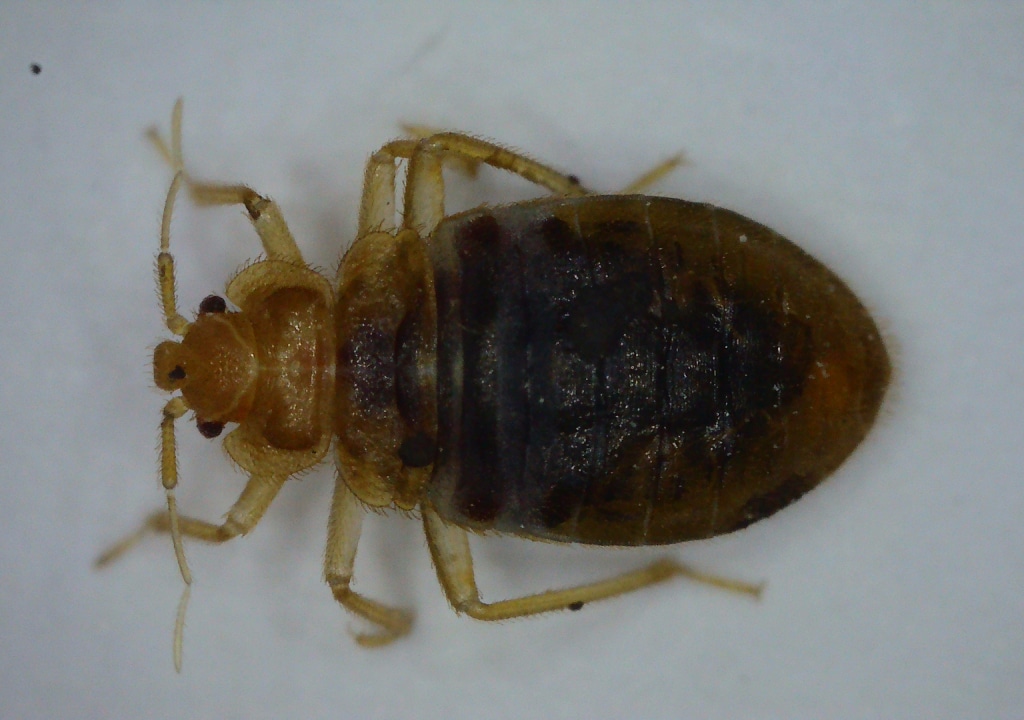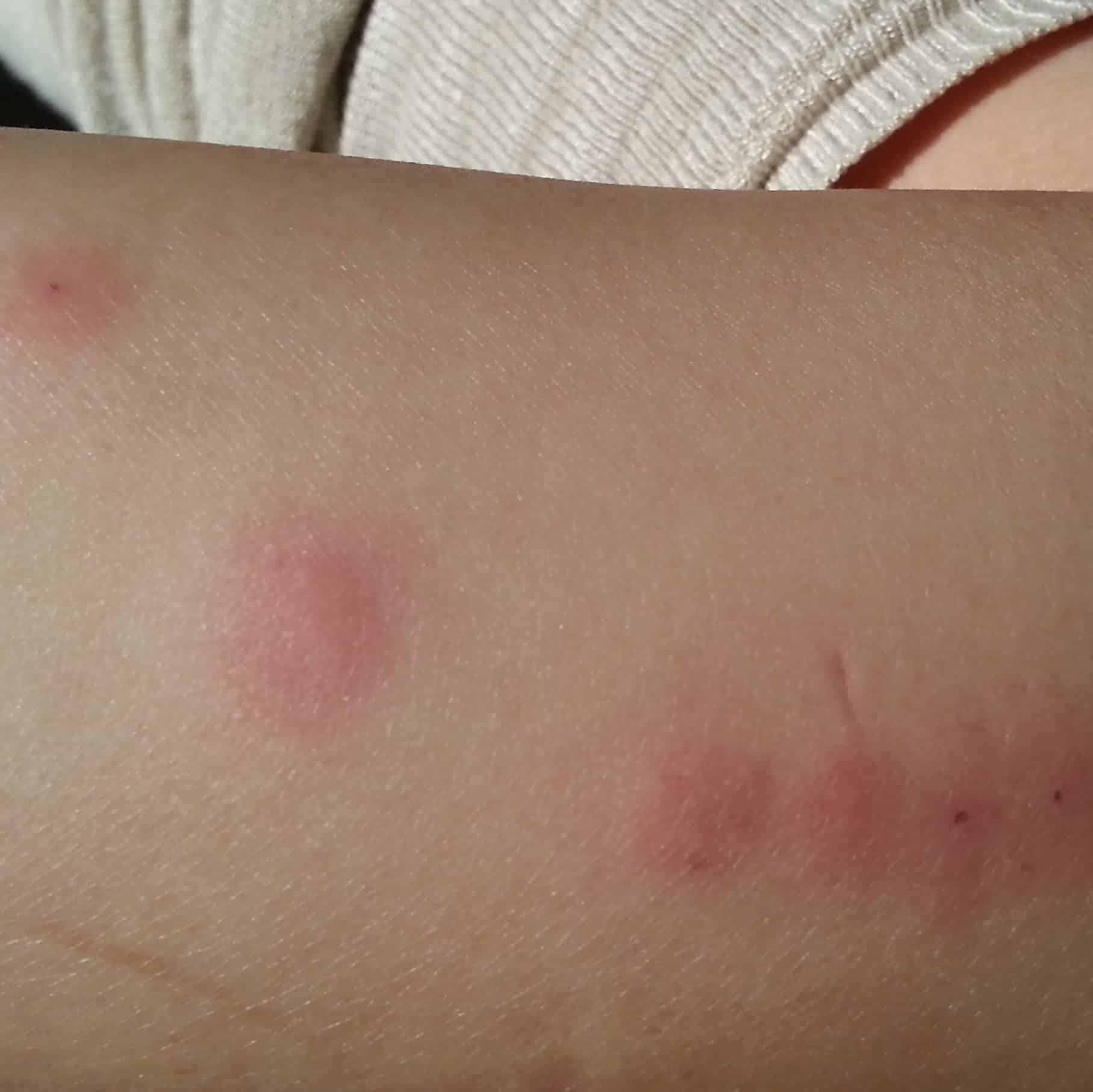
In the article
What Are Bed Bugs?
So, what are bed bugs? Bed bugs are tiny, reddish-brown insects with a flat, oval body shape. They belong to the Cimicidae family and are parasitic in nature, feeding exclusively on the blood of humans and animals while they sleep.
Adult bed bugs are roughly the size of an apple seed (about 5mm), while nymphs are even smaller and nearly transparent. Because they’re nocturnal and expert hiders, spotting them can be tricky.
Identifying what are bed bugs involves looking out for these unique characteristics:
- Shape: Oval and flat, making them adept at hiding in cracks and crevices.
- Color: Reddish-brown after feeding and lighter when unfed.
- Size: Adults are 5-7mm. The newborn nymphs are tiny, but visible to the naked eye.

Bed Bug Nymph
Signs and Symptoms of Bed Bug Infestations
Ever asked yourself, “what are bed bugs signs?”
Here’s what you need to know:
- Bite marks: Bed bug bites typically appear in clusters or straight lines. They can be red, itchy, and are often mistaken for mosquito or flea bites. These marks show up on areas that are exposed during sleep, like the face, neck, arms, and hands.
- Exoskeletons: Since bed bugs shed their skin as they grow, finding these light brown, shell-like remains is a sign that you might have a growing infestation.
- Blood spots on bedding: You might notice small, rust-coloured spots on your sheets or mattresses. These are either from crushed bed bugs or their droppings.
- Musty smell: If the infestation is severe, you’ll notice a distinctive, musty odour from their scent glands.
Remember, identifying what are bed bugs isn’t just about seeing them — it’s also about recognising the signs they leave behind. Our Bed Bug Barrier Isolation System helps you detect and isolate bed bugs before they become a full-blown problem.
How Bed Bugs Spread and Where to Find Them
If you’re curious about what are bed bugs spread patterns, you’re not alone. These pests are notorious for hitching rides on luggage, clothing, and second-hand furniture. Whether you travel frequently or pick up used items, you could unknowingly bring bed bugs into your home.
Here’s where bed bugs like to hide:
- Bed seams and folds: They love to nest in the seams and folds of mattresses and box springs.
- Behind wallpaper and inside electrical outlets: Small crevices and gaps are perfect hiding spots.
- Furniture and clutter: Any cracks and crevices in furniture, such as bed frames or dresser drawers, are ideal for these pests.
Knowing what are bed bugs habits can help you locate and eliminate them more effectively. Prevention involves taking steps like isolating the bed, using mattress covers, and applying Diatomaceous Earth to the bed frame. These measures disrupt bed bugs’ movement and reduce the chances of spreading.
Health Risks and Reactions to Bed Bug Bites
Understanding what are bed bugs and their impact on health is crucial. While bed bugs aren’t known to transmit diseases, their bites can cause various health issues, including:
- Skin reactions: Bed bug bites can lead to redness, swelling, and intense itching. Some people may experience allergic reactions that result in painful swelling at the bite site or even anaphylaxis, though this is rare.
- Secondary infections: Excessive scratching of bite areas can lead to skin infections.
- Mental health impacts: Living with a bed bug infestation can cause anxiety, insomnia, and stress, as many people find it distressing to sleep knowing that bed bugs are present.
If you think you’ve been bitten, treat the area with antiseptic creams and consider using antihistamines if the itching is intense. For persistent issues, consult a healthcare professional to get specific advice on treating bed bug bites.

Bed Bug Bites
Effective Methods for Preventing and Treating Bed Bugs
Now, let’s dive into what are easy bed bugs treatments that actually work. When it comes to prevention and treatment, your best bet is to combine proactive measures with effective products.
Here’s a quick rundown of how to keep bed bugs away:
- Regular inspections: Inspect your mattress, bedding, and surrounding areas frequently. If you travel often, thoroughly check your luggage upon returning home.
- Isolate your bed: Use bed bug traps on your bed legs and keep the bed away from walls and other furniture. This creates a barrier that prevents bed bugs from reaching you while you sleep.
- Use protective covers: Bed bug mattress covers can seal off bed bugs and make spotting them easier.
- Apply Diatomaceous Earth (DE): This natural, non-toxic powder can kill bed bugs on contact. Apply the bed bug killer around your bed frame and bed legs in crevices where bed bugs are likely to hide.
- Steam and heat treatments: Bed bugs can’t survive extreme heat. Washing your bedding at high temperatures and using a steam cleaner can be effective at killing these pests.
For a comprehensive, organic solution, Bed Bug Barrier offers a DIY bed bug treatment system. Our system includes bed leg traps, mattress covers, and the use of Diatomaceous Earth to isolate and eradicate bed bugs instantly and provide long-term protection — all with just one application.
DIY Isolation Method To Get Rid Of Bed Bugs Fast & Forever
Final Word
What are bed bugs? They’re sneaky little pests that cause a lot of trouble if not dealt with swiftly. By understanding their habits, knowing how to identify them, and using the right prevention methods, you can keep your home bed bug-free and enjoy a peaceful night’s sleep.
Frequently Asked Questions:
- What Do Bed Bugs Look Like?
Bed bugs are small, flat, and reddish-brown. Adult bed bugs are about 4 to 5 mm long, while young nymphs are smaller and almost transparent. After feeding, they swell up and turn a darker shade of red. Their eggs are tiny, white, and usually found in clusters. - Signs and Symptoms of Bed Bug Infestations
Bed bug bites are typically red and itchy, appearing in lines or clusters on exposed skin. Other signs include small blood stains on bedding, dark spots (droppings), shed skins, and a musty odour, especially in severe infestations. - How Do Bed Bugs Spread and Where to Find Them
Bed bugs spread by hitching a ride on luggage, clothing, or furniture. They hide in mattress seams, bed frames, cracks in walls, and even behind wallpaper. They prefer to stay close to where people sleep but can travel to other areas if the infestation worsen.
Are You Looking for an Organic DIY Treatment?



Nancy says
One more question. Do I have to buy the duster or can i just sprinkle it around?
Tony Abrahams says
Hi Nancy. You don’t necessarily have to buy a duster, but it’s highly recommended. Sprinkling Diatomaceous Earth (DE) by hand can lead to uneven coverage, and it’s harder to reach cracks, crevices, and tight spaces where bed bugs hide. A duster allows you to apply the powder more precisely, ensuring it gets into all the necessary areas for maximum effectiveness without wasting it. Regards BBB
Nancy says
How long should i leave the powder there before removing it?
Tony Abrahams says
Hi Nancy. You should leave the powder at least 6 weeks before removing it to make sure you kill any bedbugs that havent hatched yet. Regards BBB